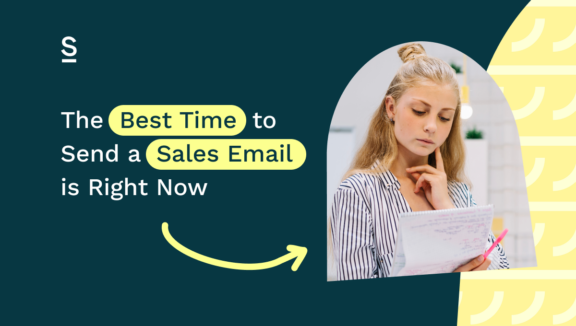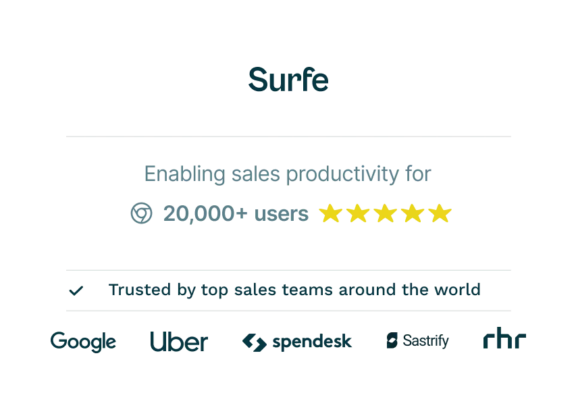The Best Time to Send a Sales Email is Right Now

We’ve all been there, sat hesitating over a painstakingly crafted email with a finger hovering over the send button. Is now the right time to activate that outreach campaign? What if no-one reads our message? Are the recipients too busy to even notice it in their inboxes?
But, waiting for the “perfect” time to send an email carries risks of its own. Prospects are bombarded with email traffic. In a professional setting, the average person receives over 121 emails per day… And if your competitor lands in your prospect’s inbox before you do, they might just clinch the deal right from underneath you.
So, this is a call out to the deliberators and the dalliers of the sales world. The best time to send a sales email to your prospects is… now. With some smart scheduling and cadencing strategies in place you can optimize your open rates and land more deals.
In this article, we’ll cover:
Delay is Decay
Prompt communication can be the difference between winning a deal and losing it to a competitor. When a prospect shows interest, they are at their peak engagement level. Responding immediately capitalizes on this interest and keeps the momentum going, demonstrating your commitment and responsiveness.
Urgency in sales
Acting swiftly in sales is not just about being quick—it’s about conveying urgency to your prospect so they know you’re invested in solving their pain points. When you follow up immediately, you signal to your prospect that their needs are your top priority. This urgency can accelerate decision-making, pushing prospects closer to a commitment before they have a chance to reconsider or get distracted.
Avoiding delay
Waiting for the “best” time to send that follow-up email or make that call is a risky strategy. In sales, hesitation can be your worst enemy. While you’re waiting, your competitors are likely acting. They’re reaching out, engaging, and potentially closing the deal while you’re still crafting the perfect message. This delay can result in missed opportunities, as prospects often go with the first responsive and engaging vendor.
To avoid this, it’s essential to strike while the iron is hot. Send that follow-up email as soon as possible after your initial contact. Show your prospect that you’re proactive and eager to solve their problems. Immediate action not only keeps you top of mind but also prevents your competitors from swooping in and stealing your lead.

Email Scheduling Secrets
Timing your sales emails correctly can significantly impact your engagement rates and overall success. Understanding the most engaged days and times to reach your audience can help your message stand out from the crowd and encourage prospects to act on it.
Best time to send sales emails: days of the week
Research shows that Tuesdays, Wednesdays, and Thursdays are the most effective days for sending sales emails. These mid-week days strike a balance between the start-of-week catch-up and end-of-week wind-down, making recipients more likely to engage with your content.
Avoid sending emails over the weekend, as Saturdays and Sundays typically have the lowest engagement rates. People are often focused on personal activities and may not check their work emails as frequently, resulting in your message getting buried or ignored.
Best time to send sales emails: time of day
Morning: Late morning, between 9 AM and 11 AM, is often the best time to reach professionals. By this time, they have likely cleared their initial morning tasks and are more open to reviewing new emails.
Afternoon: Early to mid-afternoon, from 1 PM to 3 PM, is another effective window. After lunch, many professionals have a lull in their schedule, making it a good time to catch their attention before they dive back into more intensive work.
Evening: While late afternoon or early evening can work well for certain audiences, it is generally more effective for B2C communications. For B2B sales, it’s better to stick to morning and early afternoon slots to ensure your message is seen and considered during typical working hours.
Condition-based Triggers
Okay, we have to come clean. There’s a caveat to this advice.
In truth, the most effective teams don’t just look at the best time to send sales emails for outreach, but actually aim to align their outreach emails to when a lead meets the right conditions or criteria. Rather than focusing solely on the day of the week or time of day, prioritize sending emails based on when your contacts are most ready to receive and act on your message. This ensures your communication is timely, relevant, and impactful.
Contextual Timing
User actions: Tailor your email sends to align with user actions. For example, if a user’s free trial of your product expires on a Wednesday, don’t wait until the next “best” day to follow up. Send an email immediately to encourage them to upgrade to a paid plan. This approach plays off the user’s current engagement and ensures your product remains top-of-mind.
Behavioral triggers: Responding to behavioral triggers in real-time can be a gamechanger. If a user downloads a whitepaper, follows a specific product, or abandons a shopping cart, your follow-up should be immediate. These behaviors indicate a high level of interest and engagement, making it the perfect time to send a sales email and guide them toward the next step in their journey.
Working example: When a user’s trial ends, send an upgrade offer immediately rather than waiting for the “perfect” day or time. This prompt action capitalizes on their recent interaction with your product and increases the likelihood of conversion.
Contact, Cadence, and Consistency
A well-structured email cadence can be a useful framework for nurturing leads without overwhelming them. By balancing the frequency and timing of your follow-ups, you can maintain engagement and move prospects through the sales funnel effectively without sticking to hard and fast rules about what counts as the best time to send your sales emails.
Initial contact
The first follow-up email after your initial email is crucial. It sets the tone for your ongoing communication and ensures that your prospect doesn’t forget about your offer. Aim to send this follow-up within 24-48 hours to capitalize on their initial interest and keep the conversation alive.
Optimal frequency
In a typical email sequence, spacing your emails about three days apart is generally effective. This frequency keeps you on the prospect’s radar without becoming intrusive. For example, after your initial follow-up, wait three days before sending the next email, and continue this pattern throughout your sequence.
Avoiding overwhelm
While you want to stay front of mind for your prospect, bombarding them with too many emails can backfire. Pay attention to engagement signals. If a prospect hasn’t opened your last few emails, it might be wise to extend the intervals or try a different approach. Providing valuable content in each email, such as insights or useful resources, can also help prevent your email ending up in your prospect’s deleted folder.
Balancing persistence and patience
Persistence: Consistent follow-ups demonstrate your commitment and keep the prospect engaged. Be clear and concise in your messaging, reminding them of the benefits and solutions you offer.
Patience: It’s equally important not to come across as too aggressive. If a prospect is showing interest but needs more time to decide, respect their pace. A more relaxed cadence, with a mix of follow-up emails and check-ins, can show that you’re considerate of their decision-making process.
How to Optimize Your Email Timings
Optimizing your email scheduling ensures that your messages land at the perfect moment for maximum impact. Here’s how to fine-tune your email timing to engage your audience effectively.
A/B testing
A/B testing is crucial for determining the best times and days to send emails to your specific audience. Experiment with different send times and days, then analyze the results to see which combinations yield the highest open and response rates. This data-driven approach helps you pinpoint the optimal scheduling strategy tailored to your audience’s behavior and preferences.
Automation tools
Leverage automation tools like Outreach and Salesloft to streamline and optimize your email scheduling. These platforms analyze user behavior and engagement history to recommend the most engaged send times. By automating your email campaigns, you ensure that your messages reach prospects when they are most likely to engage, without the need for constant manual adjustments.

Personalization
Tailor your email timing based on individual user data and time zones. Personalizing send times shows that you understand and respect your prospect’s schedule, increasing the likelihood of engagement. Use CRM data to segment your audience and adjust your email send times accordingly, ensuring that your messages arrive at convenient and relevant times for each recipient.
Reaching the right email address
After all the effort in optimizing your email timing, it’s vital to ensure that you’re sending to the correct email addresses. A bounced email not only wastes your effort but can also affect your sender reputation. Tools like Surfe can help verify email addresses, ensuring your meticulously timed emails reach the intended recipients.
Let’s Wrap it Up!
So, now you know exactly when the best time is to send sales emails: right now! Don’t delay your outreach for fear of your message not being seen. With the right condition-based triggers in place, your lead will be primed to read what you’re writing and have a better chance of converting from a prospect to a paying customer. And with automation tools in place, you can save yourself hours of admin time to focus on the all important closing conversations.

Want to give your sales email the best chance of being seen and opened?
Surfe’s email finder helps you minimize bouncebacks by enriching your CRM data with up-to-date email addresses. And with a 93% hit rate, it’s one of the best in the business.
Frequently Asked Questions (FAQs)
When is the best day to send a sales email?
There is no silver bullet day to send an email as your audience will have its own specific preferences and email habits, but midweek campaigns tend to yield higher open rates.
How can I make sure my email reaches my prospect?
Tools like Surfe’s email finder can help you validate your prospect’s contact details and avoid bouncebacks.
How often should I send a sales email to my prospects?
You should balance your email send cadencing so that it is consistent but doesn’t overwhelm your prospect’s inbox. Typically, this adds up to about 1 email per 3 days.


